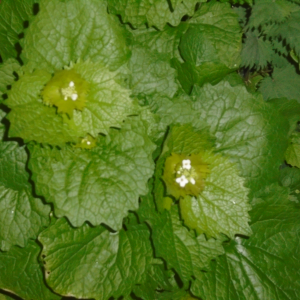Jack by the hedge
Jack by the hedge / Garlic mustard, is an easy-to-identify plant simply by its smell. It has a pleasant, mild scent of garlic when rubbed between the fingers. The leaves are a light green colour and are slightly toothed. The flowers are brilliant white, with four petals. The plant is common in Europe and can be found on hedgerows and open woods. In my local woods close to mid-spring, Jack has his foothold everywhere and announces his presence with his mild garlicky smell as you brush past him. If you like Garlic, but only want the suggestion of the garlic flavour, this will be ideal for you as an ideal flavouring.
Jack by the hedge can be found in spring from as early as February, if the weather has been good a second harvest can be found in autumn. Young leaves at the top of the plant are the most tender. The taste is a combination of garlic and mustard with a pleasant, albeit slightly bitter after taste. The leaves can be chopped and added to a salad, but a tasty treat to accompany spring lamb would be a sauce made from Jack by the hedge.
- 2 handfuls of Jack by the hedge leaves.
- 2tbs of Malt Vinegar (more if required)
- 1tsp of Sugar
It’s basically an alternative to mint sauce.
- Garlic mustard has been little used in herbal medicine.
- Leaves and stems are anti-asthmatic, antiscorbutic, antiseptic, deobstruent, diaphoretic, vermifuge and vulnerary.
- Leaves have been taken internally to promote sweating and to treat bronchitis, asthma and eczema.
- Externally, they have been used as an antiseptic poultice on ulcers etc., and are effective in relieving the itching caused by bites and stings.
- Roots are chopped up small and then heated in oil to make an ointment to rub on the chest in order to bring relief from bronchitis.
- Juice of the plant has an inhibitory effect on Bacillus pyocyaneum and on gram-negative bacteria of the typhoid-paratyphoid-enteritis group.
- Seeds have been used as a snuff to excite sneezing.
- Leaves can be used as a sudorific and deobstruent when taken internally, or as an external treatment for gangrene and ulcers.
- Leaf juices taken alone or boiled in syrup with honey were used to treat dropsy.
- Garlic mustard was once used medicinally as a disinfectant or diuretic, and was sometimes used to treat wounds.
- Leaves have been consumed to bring relief to congested chest and eczema.
- For relieving skin irritations and insect bites, these leaves might be beneficial.
- It can be used for stimulating appetite and inducing hunger which is often affected due to internal illness.
- It can be effective for keeping respiratory problems in check.
- Mild garlic and mustard flavour, the leaves are also believed to strengthen the digestive system.
In 1657 William Coles wrote that is was eaten by many country people as sauce to their salt fish, and helped well to digest the crudities and other crude humours that are engendered by the eating thereof.
Early herbalists used the leaves for dropsy and to induce sweating. The herbalist Sir John Hill recommended that they should be boiled with honey to make a syrup as a remedy for coughs and hoarseness. The leaves were also believed to have antiseptic properties and were applied as dressings to open sores and ulcers.
For magical uses performed by witches, mustards in general have a long history of protective uses, including hiding the seeds under a doormat to keep supernatural threats from crossing the threshold. More articles here.




